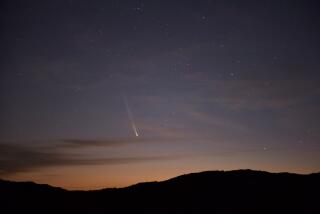Amateurs Get Into the Act on Halley’s Comet
- Share via
Mary Firth will photograph Halley’s Comet from a California mountainside. Mark Coco plans to watch it from the Galapagos Islands. Ruthi Moore may plant her lawn chair in a Hawaiian sugar cane field.
The three amateur astronomers belong to International Halley Watch, a loosely organized group mounting history’s largest study of a comet, said Stephen Edberg, an astronomer at the National Aeronautics and Space Administration’s Jet Propulsion Laboratory in Pasadena.
About 900 professional and nearly 600 amateur astronomers from more than 50 nations, including Eastern Bloc countries, will participate in the Halley Watch, which is coordinated by the JPL and West Germany’s University of Erlangen-Nurnberg.
With so many eyes turned to the skies, scientists hope to keep the comet under 24-hour watch, Edberg said.
Little Comet Information
“The reason is that we don’t know very much about comets,” he said. “We have very nice models of what we think a comet is and how it works. We’ve got a very nice edifice, but it really needs a foundation” of solid facts.
Edberg said information amassed by Halley Watch will complement data from five space probes--two Soviet, one European and two Japanese--that will fly by the comet next March, as well as from various U.S. spacecraft that will watch the comet from afar.
Halley Watch “is an excellent opportunity for an amateur to contribute data which has real meaning,” said Firth, a 57-year-old grandmother from Canoga Park. She plans to haul her telescope and cameras onto the slopes of Mt. Pinos, 75 miles northwest of Los Angeles, for two weekends a month beginning this month.
Coco, 25, a Redondo Beach computer firm employee, said he’s excited about watching and photographing the comet while leading a trip to Peru, Ecuador and the Galapagos next April because “comets are . . . strange visitors and poorly understood. They’re different from the average, run-of-the-mill objects we normally observe.”
Meteor Showers
Moore, 39, wife of a Navy submarine commander, said she will record details of fall and spring meteor showers associated with Halley’s Comet while sitting in a lawn chair “either in my backyard (in Honolulu), Barbers Point Naval Air Station or on the island of Lanai in the middle of a cane field.”
Her husband thinks her hobby “is nice,” Moore said. “When I come home at 3 a.m. in the morning, he asks all the appropriate questions and then goes back to sleep,” she said.
John Brandt, astronomy and solar physics chief at NASA’s Goddard Space Flight Center in Greenbelt, Md., said amateur astronomers will make “a vital contribution” to the study.
“These people are doing this largely out of the goodness of their hearts,” he said.
Halley Watch’s professional astronomers have been observing the comet since it was first detected on its current trip around the sun in October, 1982, Edberg said. The most careful amateurs will be able to see it through their telescopes this month and continuing well into 1986, he added. It will be visible to the naked eye next January, then again next March and April, although springtime views from the Northern Hemisphere are expected to be poor.
The Halley Watch astronomers are organized into several groups, each assigned to study a different aspect of the comet. The amateurs will mail their photos and information to recorders, such as Moore, who will judge the quality of the material before turning it over to scientists.
The scientists will compile the information into an archive, which will be published for future study.
‘Most Complete Collection’
“It will be the most thoroughly observed comet ever studied,” Edberg said. “And the archives will be the most complete collection of data on a comet ever compiled.
“It gives astronomers 10, 20, 30, 50 or 75 years from now the chance to study the data of Halley’s appearance.”
Edberg is the author of NASA’s “International Halley Watch Amateur Observer’s Manual.” He described it as a “recipe book” that contains an application form to join Halley Watch and explains how to observe the comet and record what is seen scientifically. Halley Watch members also get regular updates through a mailed news bulletin.
Halley Watch “will show that amateurs have a high degree of proficiency to do good work,” said John Sabia, a Clark Summit, Pa., amateur astronomer who will photograph the comet from an observatory in Keystone, Pa.
But for Charlie Oostdyk, a Costa Mesa computer programmer, participating in Halley Watch simply provides another opportunity view the heavens and “see all the wild and wonderful things out there.”
More to Read
Sign up for Essential California
The most important California stories and recommendations in your inbox every morning.
You may occasionally receive promotional content from the Los Angeles Times.












